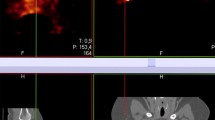Abstract
Background
In a prospective study we evaluated the accuracy, sensitivity, and specificity of single-photon-emission computed tomography (SPECT) technetium-99m (99Tcm) sestamibi scintimammography to differentiate between benign and malignant small solid lesions of the breast, and to diagnose axillary node involvement in patients with small breast tumors.
Methods
We prospectively evaluated 172 women with a solid lesion of the breast less than 3 cm in diameter and no evidence of axillary lymph node involvement on physical examination, ultrasound, and mammography. Thereafter, all patients underwent excision of the lesion, and, if pathology was positive for cancer, quadrantectomy and axillary lymph node dissection independently by the results of scintimammography.
Results
There were 92 patients with a benign lesion and 80 patients with cancer. SPECT scintimammography correctly identified all 80 patients with cancer; there were six false-positive cases and no false-negative cases for a test efficacy of 96.5%, sensitivity of 100%, and specificity of 93.5%. Forty-five of the 80 patients with cancer had axillary lymph node involvement and scintimammography correctly identified 39 of the 45 patients. There was one false-positive case and six false-negative cases for a test efficacy of 90%, sensitivity of 86.4%, and specificity of 97.5%.
Conclusion
SPECT scintimammography should be considered selectively in the preoperative evaluation of patients with small solid lesions of the breast. It allows correct identification of patients with cancer and identification of a significant number of patients with axillary lymph node involvement.


Similar content being viewed by others
References
Houssami N, Abraham LA, Miglioretti DL, Sickles EA, Kerlikowske K, Buist DS, Geller BM, Muss HB, Irwig L (2011) Accuracy and outcomes of screening mammography in women with a personal history of early-stage breast cancer. J Am Med Assoc 305:790–799
Feig SA (2007) Auditing and benchmarks in screening and diagnostic mammography. Radiol Clin North Am 45:791–800
Aarts MJ, Voogd AC, Duijm LE, Coebergh JW, Louwman WJ (2011) Socioeconomic inequalities in attending the mass screening for breast cancer in the south of Netherlands—association with stage at diagnosis and survival. Breast Cancer Res Treat 128(2):517–525
Rhodes DJ, O’Connor MK, Phillips SW, Smith RL, Collins DA (2005) Molecular breast imaging: a new technique using technetium Tc 99m scintimammography to detect small tumours of the breast. Mayo Clin Proc 80:24–30
Mechmandarov S, Sandbank J, Cohen M, Lelcuk S, Lubin E (1998) Technetium-99m-MIBI scintimammography in palpable and not palpable breast lesions. J Nucl Med 39:86–91
Gilbert FJ, Astley SM, Gillan MG, Agbaje OF, Wallis MG, James J, Boggis CR, Duffy SW, CADET II group (2008) Single reading with computed-aided detection for screening mammography. N Engl J Med 359:1675–1684
Kalager M, Zelen M, Langmark F, Adami HO (2010) Effect of screening mammography on breast-cancer mortality in Norway. N Engl J Med 363:1203–1210
Medeiros LR, Duarte CS, Rosa DD, Edelweiss MI, Edelweiss M, Silva FR, Winnikov EP, Simoes Pires PD, Rosa MI (2011) Accuracy of magnetic resonance in suspicious breast lesions: a systematic quantitative review and meta analysis. Breast Cancer Res Treat 126(2):273–285
Warner E, Messersmith H, Causer P, Eisen A, Shumak R, Plewes D (2008) Systematic review: using magnetic resonance imaging to screen women at high risk for cancer. Ann Int Med 148:671–679
Landercasper J, Linebarger JH (2011) Contemporary breast imaging and concordance assessment. A surgical perspective. Surg Clin North Am 91:249–266
Satake H, Nishio A, Ikeda M, Ishigaki S, Shimamoto K, Hirano M, Naganawa S (2011) Predictive value for malignancy of suspicious breast masses of BI-RADS categories 4 and 5 using ultrasound elastography and MR diffusion-weighted imaging. AJR Am J Roentgenol 196:202–209
Spanoudaki VC, Lau FW, Vandenbrouke A, Levin CS (2010) Physical effects of mechanical design parameters on photon sensitivity and spatial resolution sensitivity of a breast-dedicated system PET system. Med Phys 37:5038–5049
Chowdary PD, Jiang Z, Chaney EJ, Benalcazar WA, Marks DL, Gruebele M, Boppart SA (2010) Molecular histopathology by spectrally reconstructed nonlinear interferometric vibrational imaging. Cancer Res 70:9562–9569
Coover LR, Caravaglia G, Kuhn P (2004) Scintimammography with dedicated breast camera detects and localizes occult carcinoma. J Nucl Med 45:553–555
Brem RF, Schoonjans JM, Kieper DA, Majewsky S, Goodman S, Civelek C (2002) High-resolution scintimammography: a pilot study. J Nucl Med 43:909–915
Mueller B, O’Connor MK, Blevis I (2003) Evaluation of a small cadmium zinc telluride detector for scintimammography. J Nucl Med 44:602–609
Mankoff DA, Dunwald LK, Gralov JR et al (2002) Tc-99m-sestamibi uptake and washout in locally advanced breast cancer are correlated with tumour blood flow. Nucl Med Biol 29:719–727
Kuenen-Booumesteer V, Menke-Phymers M, de Kanter AY, Obdeijn IMA, Urich D, Van de Kwast TH (2003) Ultrasound-guided needle aspiration cytology of axillary nodes in breast cancer patients: a preoperative staging procedure. Eur J Cancer 39:170–174
Lumachi F, Tregnaghi A, Ferretti G, Popolato M, Marzola MC, Zucchetta P, Cecchin D, Bui F (2006) Accuracy of ultrasonography and 99m Tc-sestamibi scintimammography for assessing axillary lymph node status in breast cancer patients: a prospective study. Eur J Surg Oncol 32:933–936
Dunwald LK, Gralow JR, Ellis GK, Livingston RB, Linden HM, Lawton TJ, Barlow WE, Schubert EK, Mankoff DA (2005) Residual tumour uptake of 99m-Tc-sestamibi after neoadjuvant chemotherapy for locally advanced breast carcinoma predicts survival. Cancer 103:680–688
Author information
Authors and Affiliations
Corresponding authors
Additional information
An erratum to this article can be found at http://dx.doi.org/10.1007/s00268-011-1390-2
Rights and permissions
About this article
Cite this article
de Cesare, A., Vincentis Giuseppe, D., Stefano, G. et al. Single-Photon-Emission Computed Tomography (SPECT) with Technetium-99m Sestamibi in the Diagnosis of Small Breast Cancer and Axillary Lymph Node Involvement. World J Surg 35, 2668–2672 (2011). https://doi.org/10.1007/s00268-011-1267-4
Published:
Issue Date:
DOI: https://doi.org/10.1007/s00268-011-1267-4




